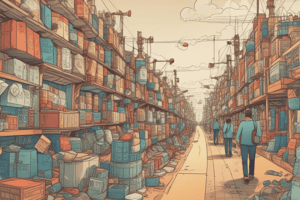Podcast
Questions and Answers
What does scarcity force individuals and societies to do?
What does scarcity force individuals and societies to do?
- Make choices about resource allocation (correct)
- Ignore resource limitations
- Increase production without constraints
- Fulfill all unlimited wants
What is opportunity cost primarily concerned with?
What is opportunity cost primarily concerned with?
- The value of the next best alternative forgone (correct)
- The financial expense associated with a decision
- The total benefits received from a chosen option
- The cost of the least desirable option
According to the law of demand, what happens when the price of a good decreases?
According to the law of demand, what happens when the price of a good decreases?
- The quantity demanded decreases
- The quantity supplied increases
- The quantity demanded increases (correct)
- The demand curve shifts left
Which of the following best describes a market economy?
Which of the following best describes a market economy?
Which factor is NOT typically associated with affecting shifts in supply and demand curves?
Which factor is NOT typically associated with affecting shifts in supply and demand curves?
In which economic system does the government make all economic decisions?
In which economic system does the government make all economic decisions?
What is the goal of an economic system generally aimed at achieving?
What is the goal of an economic system generally aimed at achieving?
What occurs at market equilibrium?
What occurs at market equilibrium?
Flashcards are hidden until you start studying
Study Notes
Microeconomics Study Notes
Scarcity and Choice
- Scarcity: Limited availability of resources compared to unlimited wants.
- Forces individuals and societies to make choices about resource allocation.
- Choices: Determined by preferences, priorities, and resource limitations.
- Every choice has consequences, influencing production and consumption.
Opportunity Cost
- Defined as the value of the next best alternative forgone when making a choice.
- Important for understanding trade-offs in decision-making.
- Can be expressed in various forms: time, money, or resources.
- Helps in evaluating the relative worth of different options.
Supply and Demand
- Law of Demand: As the price of a good decreases, the quantity demanded increases, and vice versa.
- Law of Supply: As the price of a good increases, the quantity supplied increases, and vice versa.
- Market Equilibrium: Occurs when quantity supplied equals quantity demanded.
- Shifts in Curves: Factors like consumer preferences, income, and production costs can shift the supply and demand curves, affecting equilibrium price and quantity.
Economic Systems
- Types of Economic Systems:
- Market Economy: Decisions based on supply and demand; minimal government intervention.
- Command Economy: Central authority makes all economic decisions; controls production and distribution.
- Mixed Economy: Combines elements of both market and command economies; private enterprise exists alongside government regulation.
- Factors Influencing Economic Systems:
- Cultural values, historical context, and political structures.
- Goals of Economic Systems: Efficiency, equity, economic growth, and stability.
Scarcity and Choice
- Scarcity arises from limited resources against unlimited human wants, necessitating choices.
- Choices reflect individual and societal preferences and priorities, given resource limitations.
- Every choice made results in consequences that affect both production techniques and consumer behavior.
Opportunity Cost
- Opportunity cost represents the value of the next best alternative that is forfeited when a decision is made.
- Understanding opportunity costs is crucial for analyzing trade-offs in various decision scenarios.
- It can be quantified in terms of time, monetary value, or other resources, facilitating better decision-making.
- This concept aids in assessing the comparative value of options in economic choices.
Supply and Demand
- The Law of Demand indicates that a decrease in the price of a good leads to an increase in the quantity demanded, and vice versa.
- The Law of Supply states that an increase in the price of a good results in an increase in the quantity supplied, with an inverse relationship noted.
- Market equilibrium is achieved when the quantity supplied equals the quantity demanded, stabilizing prices in the market.
- Shifts in supply and demand curves can occur due to factors such as changes in consumer preferences, income levels, and production costs, which in turn affect equilibrium price and quantity.
Economic Systems
- Economic systems can be categorized into:
- Market Economy, driven by supply and demand with limited government intervention.
- Command Economy, where a central authority directs all economic activities, controlling production and resource allocation.
- Mixed Economy, which integrates elements of both market and command systems, allowing private enterprises to coexist with government regulation.
- Various factors influence the development of economic systems, including cultural values, historical context, and political frameworks.
- Key objectives of economic systems involve achieving efficiency, ensuring equity, promoting economic growth, and maintaining stability.
Studying That Suits You
Use AI to generate personalized quizzes and flashcards to suit your learning preferences.




